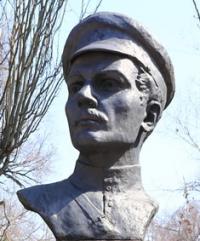You are here
Bust Furmanov in Almaty.

Beautiful places of Almaty.
“Nothing inspires so much as the consciousness of one's hopeless position”
Albert Camus.
A trip from Pavlodar to Almaty.
The monument-bust of the revolutionary commissar Dmitry Furmanov was erected in Almaty in 1967 at the intersection of Furmanov streets (now Nursultan Nazarbayev Avenue and Kurmangazy St. The height of the monument is 2.7 meters.
At the end of November 2017, Furmanov Street in Almaty was renamed Nursultan Nazarbayev Avenue. Dmitry Andreyevich Furmanov (October 26 (November 7), 1891, the village of Sereda, Russian Empire - March 15, 1926, Moscow, the RSFSR, USSR) - Soviet prose writer, revolutionary, military and political figure.
The most famous from the literary heritage of Furmanov was the novel "Chapaev." In the days of his youth, Furmanov studied at the Kinesham Real School. And although he lived in Kineshma for only about three years (1909 - 1912), they were important for the formation of his worldview and the formation of character.
It was in a real school that Dmitry Furmanov finally decided to devote his life to literature. After his graduation in August 1912, he entered the University of Moscow at the Faculty of Philology, which he graduated in 1915, but did not manage to pass exams.
He took part in the First World War as a brother of mercy of the ROCC, with the rank of ensign. In the ambulance train, he met the sister of mercy Anna Nikitichnoy Steshenko and married her. In the spring of 1917, he joined the Socialist-Revolutionary-Maximalists, then moved on to the Anarchists.
He advanced during a Kornilov speech (August 1917), when he became secretary of the Headquarters of the revolutionary organizations of Ivanovo-Voznesensk. Since September, the deputy chairman of the local Council, supported the October Socialist Revolution, and ordered the arrest of striking postal and telegraph employees.
In the summer of 1918 he joined the RCP (b). At the head of the Red Guard detachment took part in the suppression of the Yaroslavl uprising. At this time, he was approaching M.V. Frunze, the then chairman of the provincial committee of the RCP (B.)
In Ivanovo-Voznesensk and the military commissar of Ivanovo-Voznesenskaya province. In the fall of 1918 he became secretary of the Ivanovo-Voznesensky district committee of the RCP (b). At the same time, on behalf of Frunze, who has already become the commissar of the Yaroslavl Military District, he leads propaganda among the military units of the district.
In early 1919, when Frunze was appointed commander of the 4th Army of the Eastern Front, he was also sent as a political worker to the Eastern Front, since March 25, the commissar of the 25th Rifle Division, commanded by V.I. Chapaev.
On June 30, 1919, due to a conflict with Chapaev (because of jealousy: Chapaev had an affair with Furmanov’s wife Anna Steshenko transferred from the division to Turkestan. From August 1919 to September 1920, he was the head of the political department of the Turkestan Front, and from the end of 1919, he was an authorized RVSR in Semirechye.
On June 12 - 19, 1920, during the uprising in the garrison of Verny (Alma-Ata), he played a key role in the liquidation of the uprising: Furmanov conducted negotiations with the rebels, dragging out time until the right parts arrived (he described this episode in the novel "Mutiny" ) Since August 1920 - in the Kuban, the commissar of the landing detachment E. I. Kovtyukha, head of the political department of the IX Kuban army.
He participated in the battles against the Ulagaevsky landing, was heavily shell-shocked, and was awarded the Order of the Red Banner. In June 1921 he came to Moscow, worked in the literary and publishing department of the Political Administration of the Revolutionary Military Council, a member of the Supreme Military Editorial Council; Since November, he has been managing the editorial board of the journal Military Science and Revolution and at the same time completing philological education at Moscow University (he graduated in 1924).
In 1922, his two portraits were created by the artist Sergey Malyutin. Since September 1923, in the State Publishing House - political editor, then editor of the department of modern fiction. The grave of Dmitry Furmanov at the Novodevichy cemetery.
Literature:
Matveeva L.A. Monument to the "Warriors of Kazakhstan."
In the book: Monuments of history and culture of Almaty. The catalog of documents of the Office of Archives and Documentation and the Central Administration of the City of Almaty.-Almaty, Oner Publishing House, 2003, p. 183
Authority:
Vladimir Proskurin (Berlin).







